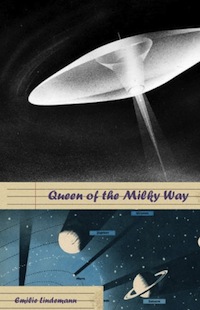Book Review
Emelie Lindemann, Queen of the Milky Way, Dancing Girl Press, 2013
Reviewed by Lisa Vihos
In The Queen of the Milky Way, we meet right away a female “someone” who has landed in an unknown forest, somewhere, three-million light years from home. From the first poem, “Landing,” to the final poem, “Encore,” poet Emilie Lindemann follows her heroine’s development as she makes her way through a landscape that is both antediluvian and suburban all at once.
The poet paints a fascinating picture of our protagonist in “The First Wave of Mist,”
Those large webbed feet,
her low-hanging belly and her long hands
trailing,
knuckles brushing the leaves.
Enormous bulbous eyes.
She would only be laughed at—
Her nose like bashed-in Brussels sprouts.
This is quite an interesting creature, this queen. As she moves toward the lights of houses, she tries to assess what danger may lie ahead. Eventually, many poems later, she makes herself more or less at home, wears perfume, drinks Orange Crush, dons a tiara. Each poem echoes and builds on the one before it, and Lindemann creates a narrative in 19 poems and several accompanying collage illustrations that both illuminate and obfuscate the story.
Lindemann aptly blends free verse with prose poem interludes. She is also a confident juggler of startling juxtapositions, characters, and settings that—through her spare yet lusciously descriptive language—begin to make their own sense, as in the poem, “Cosmic Loneliness,” which begins straight from its title line:
invaded her limbs.
Potent as a signal from Mars.
A large red circle.
It was her only chance
to wear huge, furry bedroom slippers.
She liked it.
She’d been in the closet for weeks.
Now she skimmed the bushes,
then the treetops.
Sailed on over the forest.
“We have found a window.”
The stars seemed to listen.
The bushes were listening too.
The collages interspersed throughout the chapbook and certain references begin to give the reader the distinct feeling that there is some connection to the Steven Spielberg film, E.T. In fact, a note at the end of the book confirms that the poems “use and transform language” from a children’s storybook version of E.T. called The Extra Terrestrial Storybook by William Kotzwinkle. There is also reference in the end notes to a broader context for the poems that included performance and video art created with the poet’s “friend, colleague, collaborator, and partner in crime,” Erin LaBonte.
But the chapbook stands well on its own, although I did need several reads to get into the story and to become grounded in Lindemann’s metaphoric landscape, not unlike the alien queen who struggles to make herself feel at home. After reading through the chapbook a few times, I found myself relating more and more to the Queen. She was not just some random alien plunked down in suburbia. I began to see her as an archetypal female of the earthly variety. She starts out uncertain, and evolves from a state of confusion and fear to a poised and fearless beauty. In the final poem, a prose poem called “Encore,” we read:
…It’s a beauty queen’s second appearance—a close up of her cleavage and poreless complexion. The hatch opens one last time and the lavender mists settle. The tendril of hair emerges to greet the universe. Her heart-light pulsating: Good Bye! Good Bye! Don’t bite yourself in the heart!
She has changed, this creature, from the night of her arrival at the beginning of the chapbook, when she was all bulbous eyes and Brussels sprouts nose.
Using the E.T. saga as a springboard, Lindemann presents a set of codes to be unlocked and interpreted. There is an overall strange and lovely metamorphosis that unfolds as the poems progress, and I’m sure that no two readers will decode this shift in exactly the same way, nor should they. I found the poems as a group to be both mystifying (in fact, there is a lot of reference to “mist” in many of them) and engaging. I admire the poet’s ability to use a popular contemporary tale to venture into unknown territory. In The Queen of the Milky Way, Lindemann does a wonderful job of making what is alien, familiar and what is familiar, exceedingly strange.
Lisa Vihos has two chapbooks, A Brief History of Mail (Pebblebrook Press, 2011) and The Accidental Present (Finishing Line Press, 2012). She is an associate editor of Stoneboat and an occasional guest blogger for The Best American Poetry digital.


